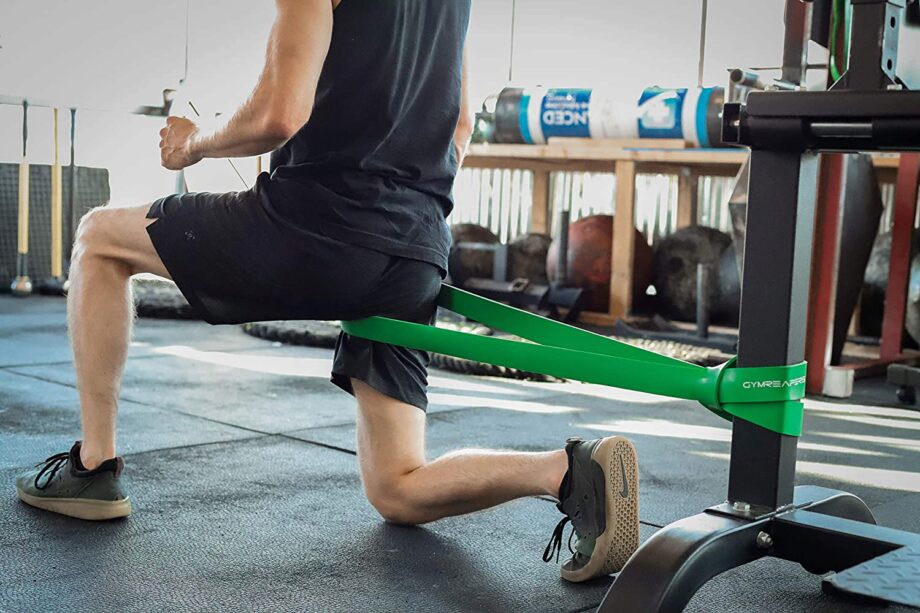We test and review fitness products based on an independent, multi-point methodology. If you use our links to purchase something, we may earn a commission. Read our disclosures.
Whether recovering from an injury or looking to expand your pull-up skills, resistance bands are versatile and low-impact training tools that can offer a variety of fitness benefits.
Due to this versatility, you can use resistance bands in a ton of ways, from securing them on bars in the park to benches and squat racks in the gym. Furthermore, resistance bands are lightweight despite still offering many of the strength training benefits associated with weights. As a result, resistance bands are easy to pack and use anywhere, whether on-the-go when traveling or in a park on a sunny day when you’d prefer to avoid the gym.
In this article, I want to help you better understand using resistance bands in the most effective way possible, according to your fitness goals and needs. With so many benefits of resistance bands and types to choose from, let’s get right into it!
Why Should You Use Resistance Bands?
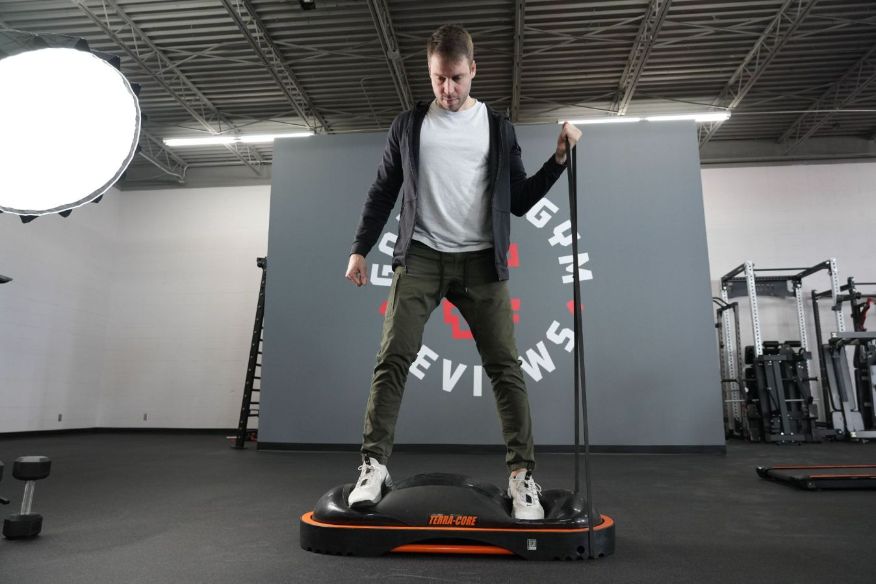
Resistance bands offer both fitness and practical benefits. Notably, a 2019 study in SAGE Open Medicine1 found that resistance bands can help individuals achieve similar strength gains as conventional resistance machines. Considering this, it’s no surprise how popular they have become for those looking to save money or those who can’t make it to the gym.
While we have covered some of the reasons you should explore resistance bands in-depth before, let me note here a few additional stand-out reasons that come to mind:
- They offer a low-impact way to develop muscle and gain strength with a lower risk of injury.
- They are far more affordable than conventional weights while still offering similar benefits.
- They can help improve your technique in various exercises or advance your fitness level more safely.
- They can be easily incorporated into various exercises and training, from pull-ups and squats to kickboxing and sprints.
- They are accessible regardless of your age or fitness status.
- They are compact, light, and easy to travel with, allowing you to train almost anywhere.
- They can offer a safe way to begin training again during recovery from or following an injury.
- They can help improve flexibility.
Types of Bands
The number of different types of resistance bands varies depending on who you ask. There are various types of bands, with each band also coming in different colors representing different levels of tension and resistance.
Here, I want to note the five most common types of bands and what they are best used for:
Loop bands: Loop bands have a flat surface and can be compared to a giant rubber band. They tend to be used more for strengthening the lower body, as they are especially helpful in targeting the glutes, quads, and hamstrings. You can do lunges, squats, good mornings, and more with these.
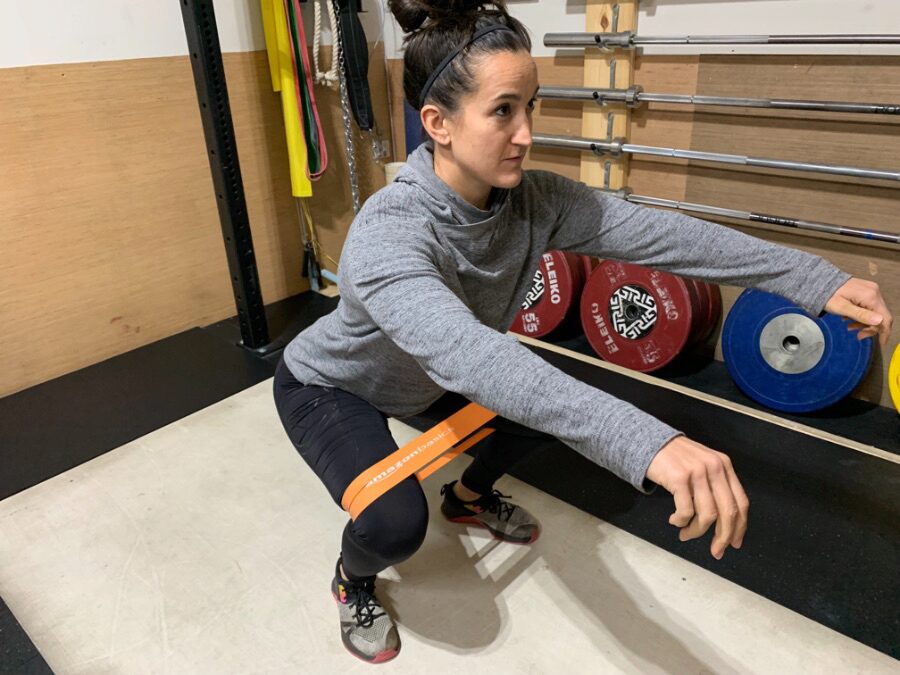
Therapy bands: Therapy bands are flat-surfaced elastic bands and are typically lighter and offer less resistance than other bands. They do not loop, rather, they are like a long, stretchy string. Therapy bands help increase your range of motion while recovering from injuries or experiencing chronic pain while also helping those overcoming injuries to safely begin engaging in resistance-based training again.
Mini bands: Also called “glute loops” and “hip circles,” this type of band mimics a loop band, but is much smaller. They are designed to wrap around your right leg and left leg simultaneously, usually resting just above or below the knees. Most people use these for doing a lot of repetitions of movements with a small range of motion, such as a standing hip abduction.
Power resistance bands: These bands are usually extra long and help with technique and motion during pull-ups, bench presses, or other exercises where an anchor point is available for the band to assist your movement.
Tube bands and tube bands with handles or straps: Tube bands are tubular rather than flat-surfaced and typically offer longer-distance use. Tube bands with handles are great for adding resistance to upper-body training that involves the hands, such as boxing or bicep curls.
Conversely, tube bands with straps are great for lower-body exercises, such as short sprints, leg swings, or other exercises where the tube band can be attached to your ankles. As you might guess, regardless of which type you choose, these bands have a grip apparatus (handle or strap) on the end of the band.
Additionally, tube bands offer a great way to incorporate resistance-based strength training in cardio exercises usually focused on weight loss.
Figure 8 bands: Figure 8 bands are tubular bands resembling a figure eight knot. These bands primarily work the arms, chest, shoulders, or general upper body. They are especially great for single-arm exercises such as bicep curls. However, they can also aid lower body exercises, such as adding resistance to leg swings.
How to Choose the Right Band
Choosing the right band or collection of bands depends on your fitness level, goals, and experience using them. Here are a few suggestions for getting the right resistance band or bands to get yourself started or advanced.
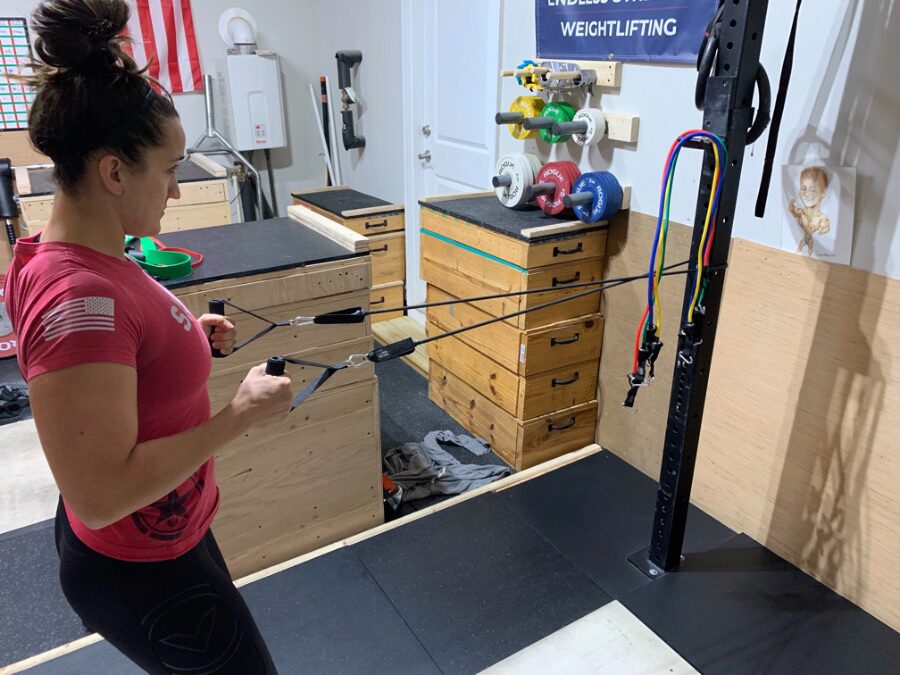
Grab Different Types of Bands at Different Levels of Resistance
Fortunately, resistance bands are dramatically cheaper than free weights or universal-weight machines, giving you some financial wiggle room to experiment with different bands.
If you are just beginning to experiment with exercise bands, try to grab a set of different types and explore the benefits of each kind of band. Then, with training and commitment over time, you can better understand how to use them properly and which types of bands best suit you.
Furthermore, whether incorporating bands into a cardio routine or purely seeking a strength-training experience, consider grabbing a set of bands that also offer various tensions and resistance levels.
By doing this in advance, you can better establish and pursue concrete goals by allowing you to increase the intensity and tension of your workouts as you learn from experience and advance your strength.
Pay Attention to the Materials Used
Most resistance bands are made using either rubber latex or synthetic rubber/fabric alternatives.
Latex bands tend to be the strongest of resistance bands and can offer a great deal of reliable resistance and tension for training. However, despite being more eco-friendly due to their naturally sourced materials, they may be problematic if you have latex allergies.
Non-latex fabric or synthetic rubber-based bands tend to have a longer shelf life than latex bands. However, they may not offer the same quality level of elasticity and resistance as latex bands. Furthermore, despite being less eco-friendly, they may be ideal for those prone to latex allergies.
Go for the Best Resistance Bands You Can Afford
Whether maintaining a tight budget or spending a few extra bucks, make sure you’re getting a quality resistance band! Of course, you should always check for any rips or tears in your bands before use, but beyond lifespan, you don’t want a band that easily breaks mid-exercise and causes an injury due to poor or cheap quality.
Research!
Take some time to learn some exercises offered by different bands before buying them. Whether to increase flexibility, safely train while recovering from an injury, or gain muscle, reading and learning about different bands and band exercises in advance can better inform you of which type of bands can best help you achieve your fitness goals.
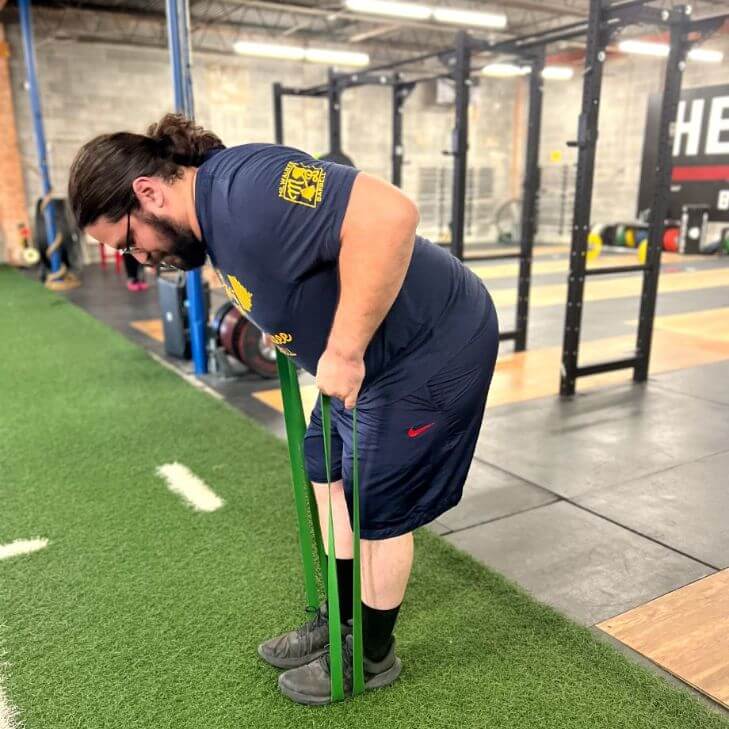
When to Use Resistance Bands
Resistance bands offer a variety of uses, from strength training to stretching. Here are just a few of the main benefits of this versatile workout tool.
Strength Training
Resistance band training offers a great alternative to free weights and conventional resistance machines. For example, you can use them to replicate dumbbell, barbell, or kettlebell exercises with less risk of injury.
Stretching
Resistance bands can help you to get a better stretch. Especially for the lower body, resistance bands can help you to push your stretches further and keep them more controlled.
Warming Up or Transitioning Into Harder Exercises
Resistance bands offer a dynamic way to transition into a more intense workout. For example, you can begin your pull-ups with a power band aiding you against gravity, then remove the band and engage in an unassisted pull-up. Beyond this, resistance bands (particularly low-resistance ones) can offer a light-pre-workout warm-up to prepare your body for heightened intensity.
Recovery
Due to the low-impact nature of resistance bands, they offer a great way to begin engaging in resistance-based training while overcoming or following an injury. Therapy bands, in particular, are designed for just this and provide an excellent way for those of us (myself included) who hate taking time off from training to find some workout time without worsening our injuries.
Adding a Strength Element to Any Routine
Whether you are kicking pads, running sprints, or engaged in some basic aerobics, adding a resistance band to the routine can easily add to the intensity of the exercise. For example, I do resistance band training sometimes for my kicks during pad training for Muay Thai using a long tube band with ankle straps. And I have to say, I love the new levels of power it helps me discover once I remove them.
Common Resistance Band Exercises
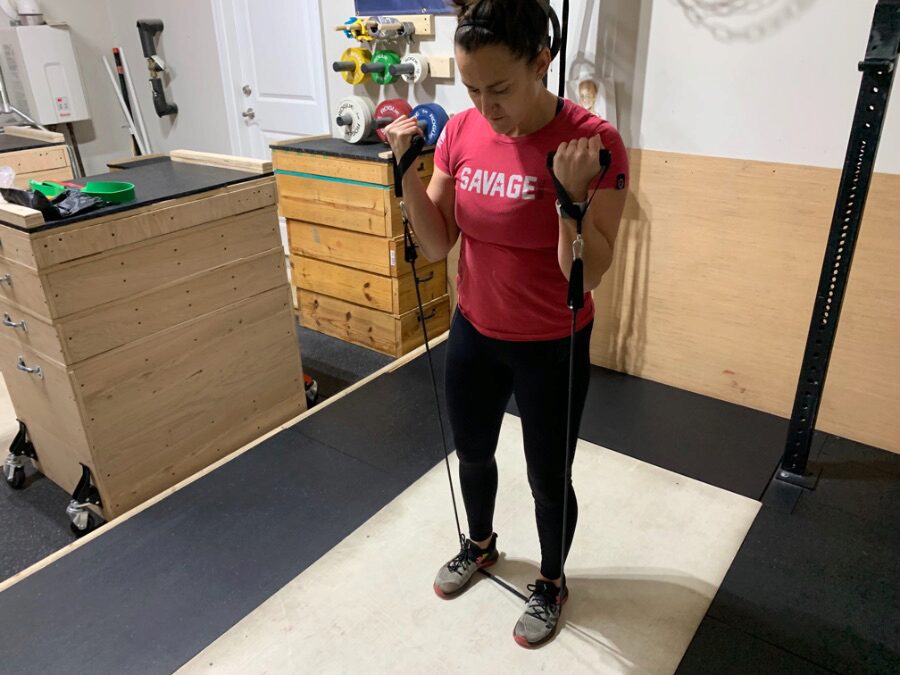
The versatility of resistance bands makes them great tools for getting a full-body workout. Here, I want to highlight some of the most common exercises you can do with resistance bands to engage your upper and lower body. I also suggest looking at our more in-depth review of some of our top picks for the best full-body resistance band workouts.
- Banded squats: Works glutes, quads, and hamstrings
- Banded push-ups: Works shoulders, arms, and core
- Banded chest press: Works the pectorals and triceps
- Banded bicep curls: Works biceps and wrists
- Banded squat thrusts: Works triceps, chest, hamstrings, quads, and glutes
- Banded hamstring curl: Works hamstrings
- Banded mountain climbers: Works shoulders, core, hamstrings, and triceps
- Banded Russian twists: Works the core
- Banded lateral leg swings: Works inner and outer thighs
- Banded overhead tricep extensions: Works triceps
- Banded clamshells: Works glutes
- Banded deadlifts: Works glutes, quads, hamstrings, traps, lower back, shoulders, and triceps
- Banded ab twists: Works the core
- Banded good mornings: Works the hamstrings, glutes, and lower back
Using Resistance Bands: Final Thoughts
Resistance bands offer a great way to build strength and crank out the reps without stressing your joints. They are accessible for people of all fitness levels and most budgets! Discovering the potential of resistance bands can offer various fitness benefits while also allowing you to train on the go.
While it may take some time to learn the correct technique or a routine that suits you, there is no better way to find out if resistance bands are right for you than grabbing one or a set of them and experimenting with this remarkably versatile and practical exercise tool!
Using Resistance Bands: Q&A
Are resistance bands really effective?
Yes, resistance bands are really effective. A 2017 study in the European Journal of Sport Science2 comparing resistance bands to conventional-resistance machine training found that resistance bands offer comparable strength-building results when used correctly.
Furthermore, tension and resistance are two critical elements in building muscle groups, making resistance bands an obvious opportunity for strength training outside the gym and without heavy weights.
How do beginners use resistance bands?
Beginners can start using resistance bands by buying one or a band set that offers different types of bands at different resistance levels. Whether you start from one or experiment with an array of bands, like any exercise, through practice and determination, you will become more advanced with time and likely see real-life fitness results. A certified personal trainer can help you get better at using resistance bands, whether you need help with your squat position, overhead press, or something else.
Is it OK to use resistance bands everyday?
It may be technically okay to use resistance bands every day, however, most trainers wouldn’t recommend it. Instead, I would suggest always taking a break between your training sessions. This is to help you avoid a fitness plateau and allow your muscles some time to recover and grow. I suggest doing resistance training four or five times a week, with a day or two in between training days.
How long should I use resistance bands for?
You can use resistance bands as long as they offer a beneficial workout routine. There is no set limit on using resistance bands. However, you should always keep aiming to achieve new levels of tension and resistance in the bands you use while also constantly seeking to discover new ways of using them to continue making gains and avoid monotony. Depending on your goals and preferences, you can use bands for a mere 10-minute workout to an hour-long intense training session.
References
- Santos Silva Lopes J, Flauzino Machado A, Kirsch Micheletti J, Castilho de Almeida A, Priscila Cavina A, Marcelo Pastre C. Effects of training with elastic resistance versus conventional resistance on muscular strength: A systematic review and meta-analysis. PMID: 30815258 (2019). DOI: 10.1177/2050312119831116
- Vegard M,Jarle Mork P, Vasseljen O, Bergquist R, Fimland M. Multiple-joint exercises using elastic resistance bands vs. conventional resistance-training equipment: A cross-over study. (2017) DOI: 10.1080/17461391.2017.1337229
Further reading

Snake Bite Grips are an attachment that increases the diameter of a barbell or dumbbell to create thick grip. They're very similar to Fat Gripz, but with a unique, laser-etched snakeskin knurling pattern that feels as good as it looks. We do prefer these to Fat Gripz, but still recommend Fat Gripz for most due to a lower price point. Read more

Looking for a treadmill walking workout to follow? We’ve got three options here written by a certified personal trainer. Read more

Will the Freak Athlete Nordic Hyper GHD review convince you this 6-in-1 machine is your next home gym investment? Read more

The Rogue Ohio Power Bar andRogue Ohio Bar are two of the most popular barbells Rogue Fitness sells and also likely two of the most popular in the world. We get asked often what the differences are between the two and who should pick which. In this comparison review, we answer that question… Read more

